Clam Chowder
Chowder...With Clams

What Is Clam Chowder?
Clam chowder is a type of soup that is typically made with clams, potatoes, onions, and cream or milk. There are several variations of the dish, including New England-style and Manhattan-style, each with slightly different ingredients and preparation methods. New England-style chowder is typically thicker and creamier, while Manhattan-style chowder is made with tomatoes and has a thinner consistency. My personal favorite is the New England style, so that is what this recipe will entail.
Ingredients For Clam Chowder
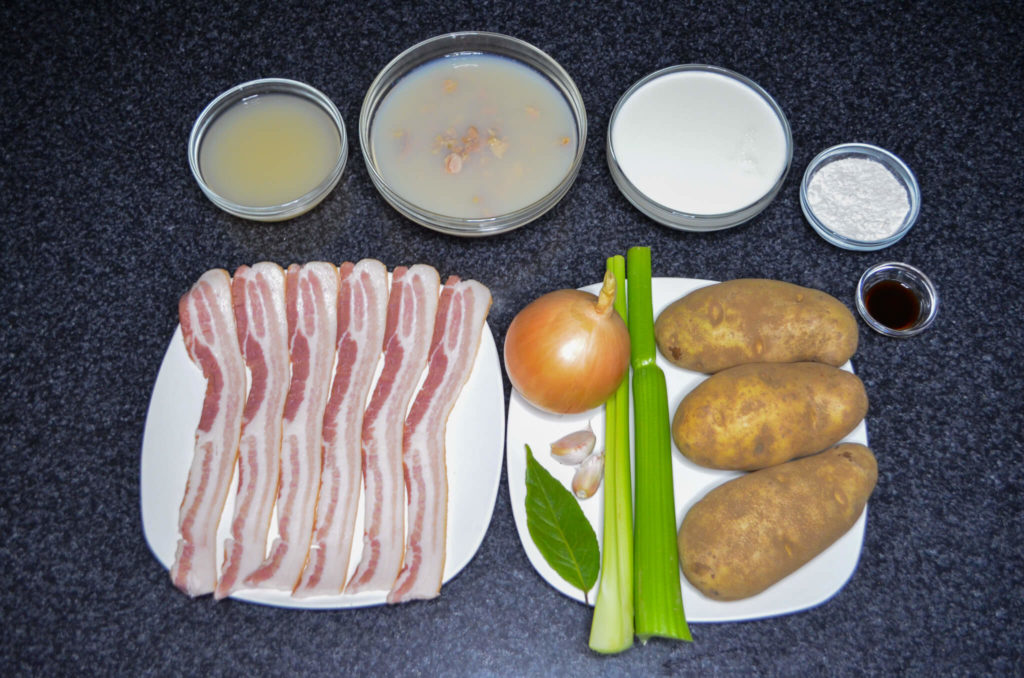

Produce
2 Stalks Celery
2-3 Russet Potatoes
2 Garlic Cloves
1 Sweet Onion
1 Bay Leaf
Refrigerated
2 Cups of Half & Half

Grocery
4 Cans of Minced Clams
1 8oz Bottle of Clam Juice
6 Tbsp of Flour
1 Tbsp Worcestershire Sauce

Meat
6 Slices of Bacon
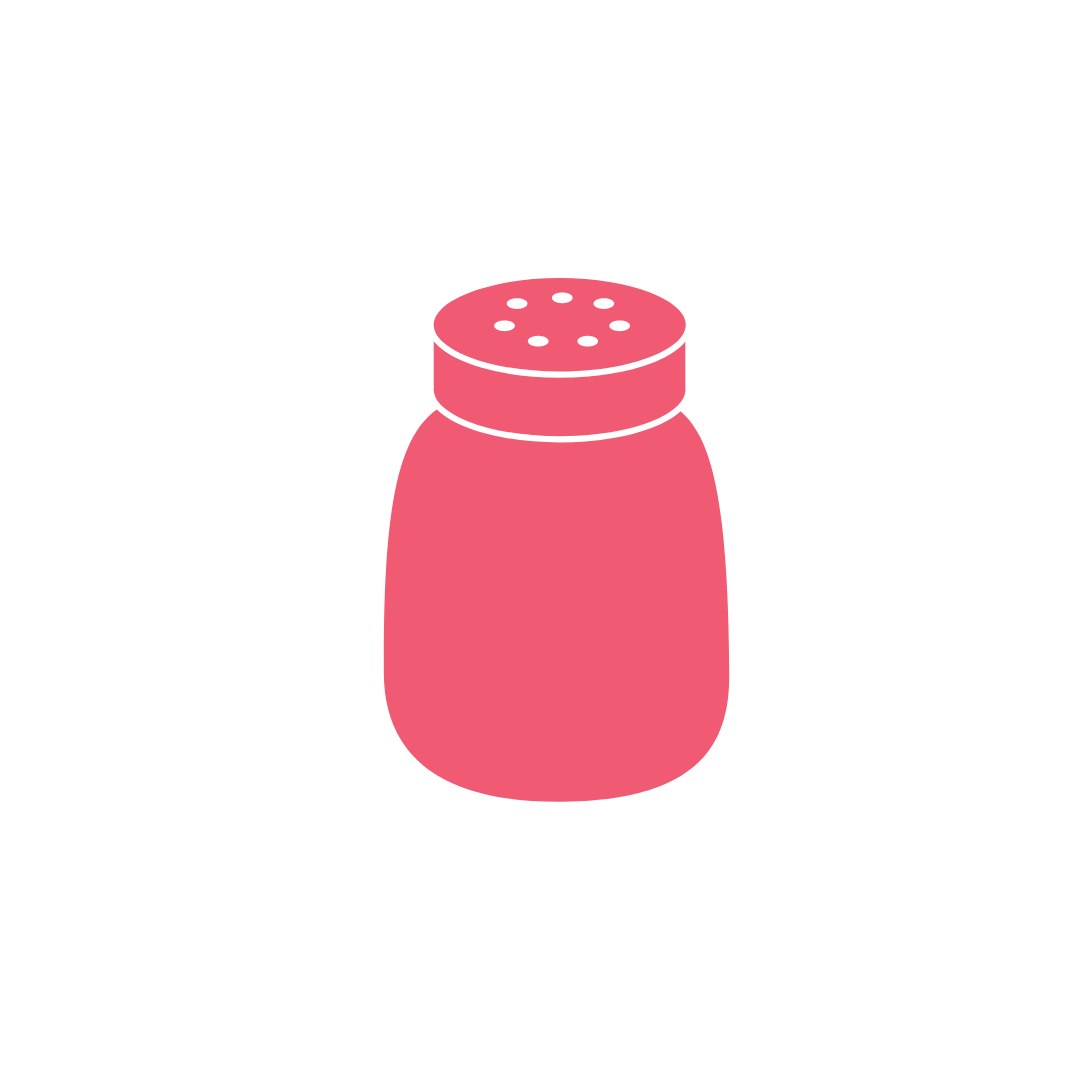
Spices
1 Tsp Thyme
1 Tsp Salt
1 Tsp Old Bay Seasoning
1 Tsp Pepper
1/2 Tsp Paprika
1/2 Tsp Garlic Powder
1/2 Tsp Onion Powder
How To Make Clam Chowder
Step 1
Prep Produce & Bacon

It is important to wash potatoes before cooking or eating them to remove any dirt, bacteria, or pesticides that may be on the surface. This helps to ensure that the potatoes are safe to consume and can also improve the taste and texture of the finished dish.
Wash and peel the skin of the potatoes, then soak them in water for 20 minutes while you continue to prep. Soaking potatoes before use can help to remove excess starch, which can lead to a more crisp and evenly cooked final product.
Additionally, soaking can also help to remove any potential impurities, such as pesticides or dirt, that may be on the potatoes. Soaking also helps to reduce the amount of water that is absorbed by the potatoes during cooking, which can lead to a more flavorful and less watery dish.
Dice your onion and celery, which are an absolute necessity. Onions and celery are often used as a base for soups, stews and other dishes because they provide a subtle yet distinct flavor and aroma.
Onions, in particular, are known for their ability to add depth and complexity to soups and other dishes, while celery adds a subtle sweetness and crunch. Both onions and celery are also rich in vitamins and minerals, and they can help to boost the nutritional value of soups.

Once the onion and celery are diced, mince your garlic and set aside. After that, dice your bacon into smaller pieces.
Step 2
Cook Bacon & Produce

If you don’t already have one, I would highly recommend making the investment and buying a dutch oven. Dutch ovens are versatile cookware that are perfect for slow-cooking, braising, and one-pot meals. They retain heat well, allowing for tender and flavorful dishes. They can be used on the stovetop, in the oven, or even over a campfire, making them versatile.
The heavy bottom and lid allow for even heating and browning of food. They are durable and long-lasting, often made of cast iron or enameled cast iron. They are a great investment for the kitchen, making cooking more enjoyable and flavorful.
Slowly cook your bacon on low heat in the cast iron. Cooking bacon on low heat is recommended because it allows the bacon to cook more evenly and prevents it from burning. When bacon is cooked on high heat, the outside can become crispy and burnt while the inside remains raw. Cooking on low heat allows the bacon to cook through more slowly, which can help to prevent it from shrinking or curling as much.
Cooking on low heat also allows the bacon to release more of its fat, which can be used to cook other ingredients or saved for later use. This can also lead to more flavorful and crispier bacon.
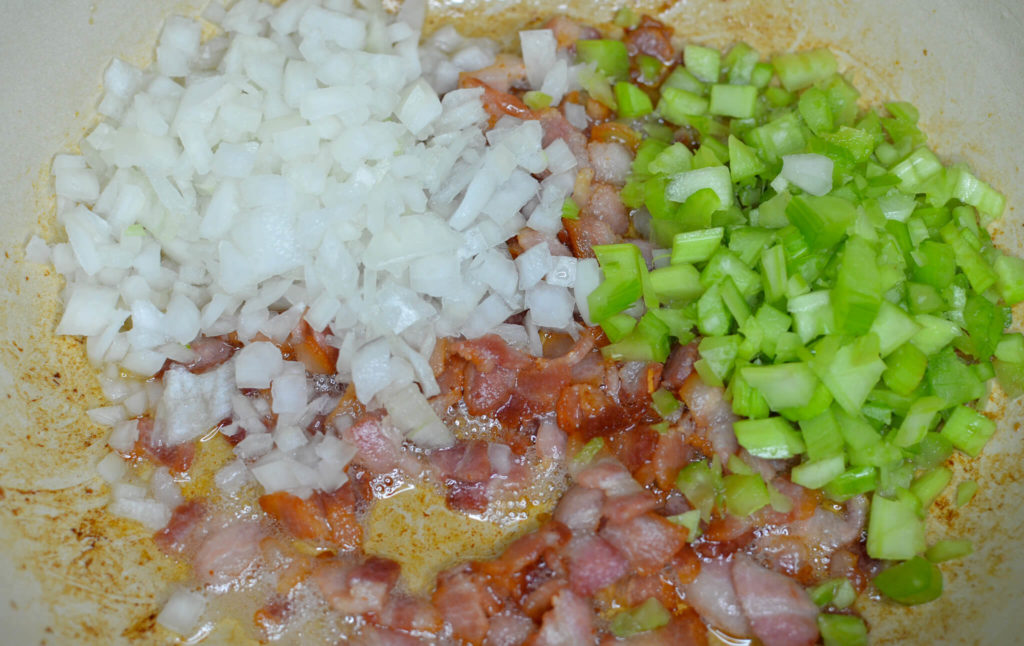
Once the bacon has cooked down enough, add the celery and onion. Cook this for another 3-4 minutes at medium-low heat, stirring often.

Add the garlic to and cook that for another 2 minutes.
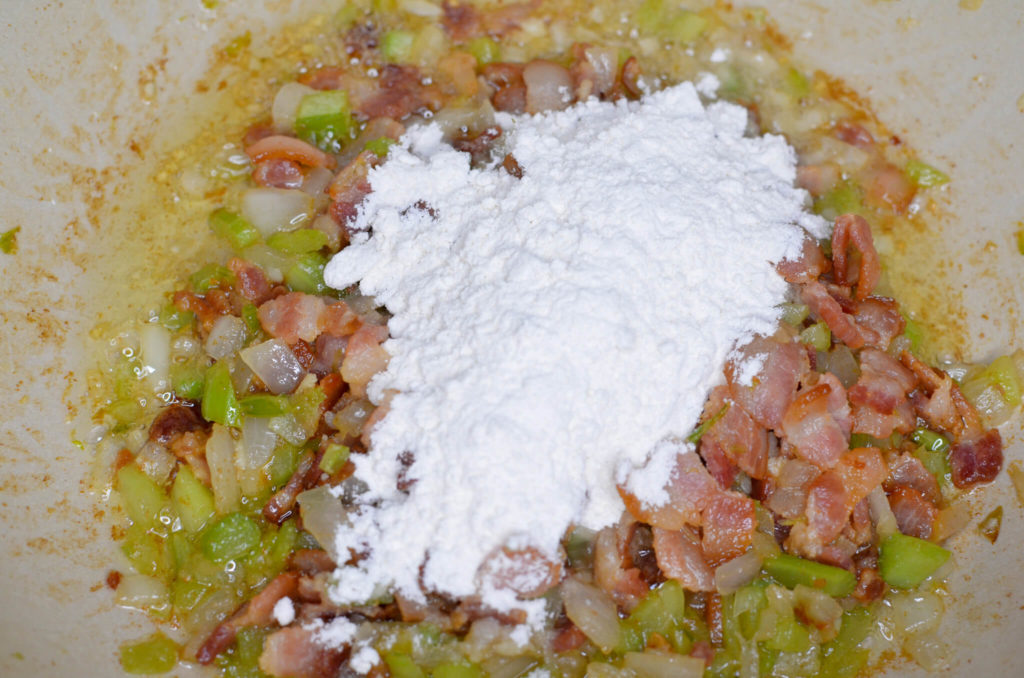
Once everything is cooked down, it’s time to make your roux. This is key to creating a great chowder, getting that thicker texture that you don’t get with most other soups. Continue to stir (or even whisk) the flour in throughout the mixture until it absorbs all of the bacon grease.

Once your bacon and veggie mixture is looking reasonably thick, it’s time to add some clam juice.
Step 3
Add Juice, Potatoes & Clams
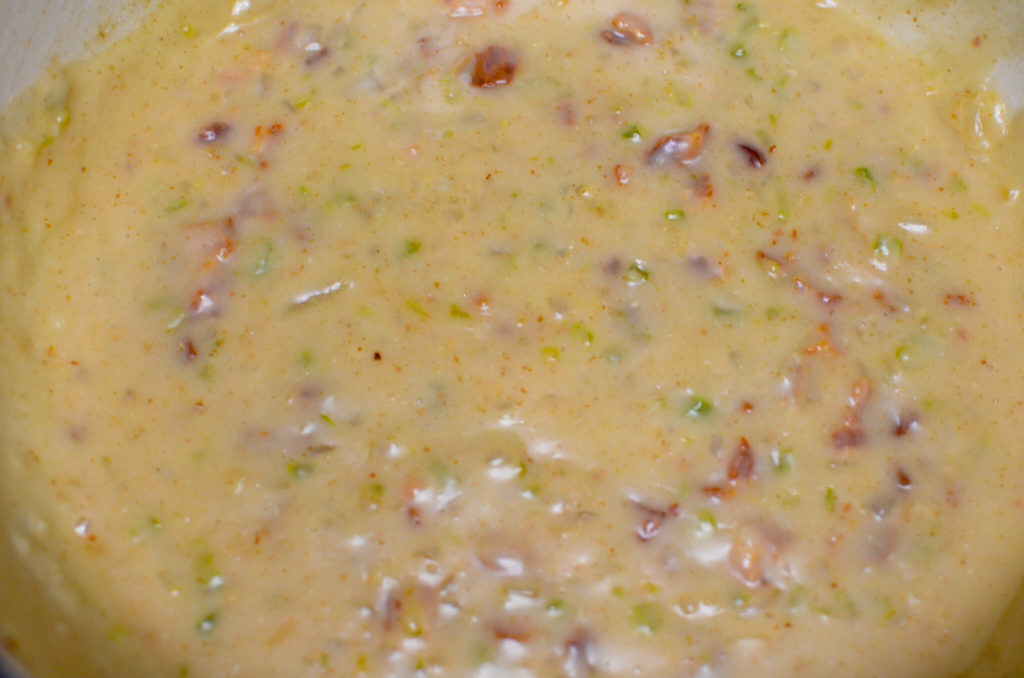
Slowly add the clam juice from the cans of chopped clams, constantly stirring to keep the consistency smooth throughout. You are more than welcome to use fresh clams instead, but I just don’t feel it’s necessary for the average home cook.

Next, add the bottle of clam juice as well, which should give you enough liquid to add your potatoes.
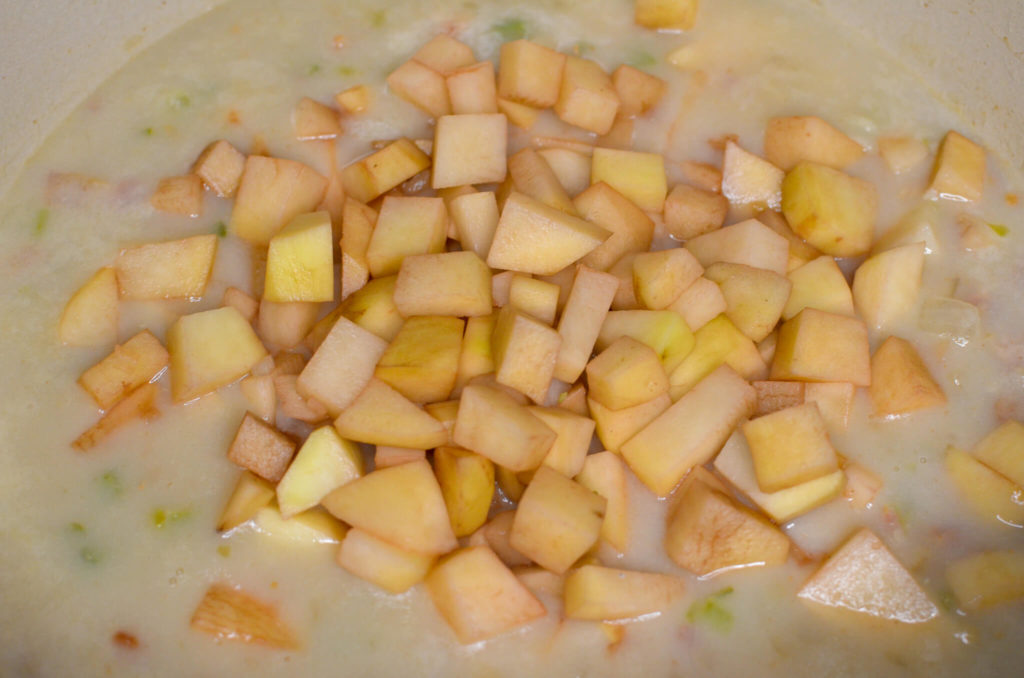
Add as much of the potatoes as you’d like, 3 russet potatoes may be too much for some, but if you love potatoes…just send it.

Stir the potatoes under the clam juice and add the bay leaf, while it may not look like much, offers a strong, distinct flavor that can enhance the taste of many dishes. They are a common ingredient in stews, soups, and sauces, and can also help to reduce the amount of salt needed in a recipe, making it a healthier alternative.

After the potatoes have cooked for about 10 minutes, add in the chopped clams and reduce heat to simmer. Keep it at this temperature for another 10 minutes to build flavors and ensure the texture of the potatoes are tender.
Step 4
Add Spices, Cream, & Simmer
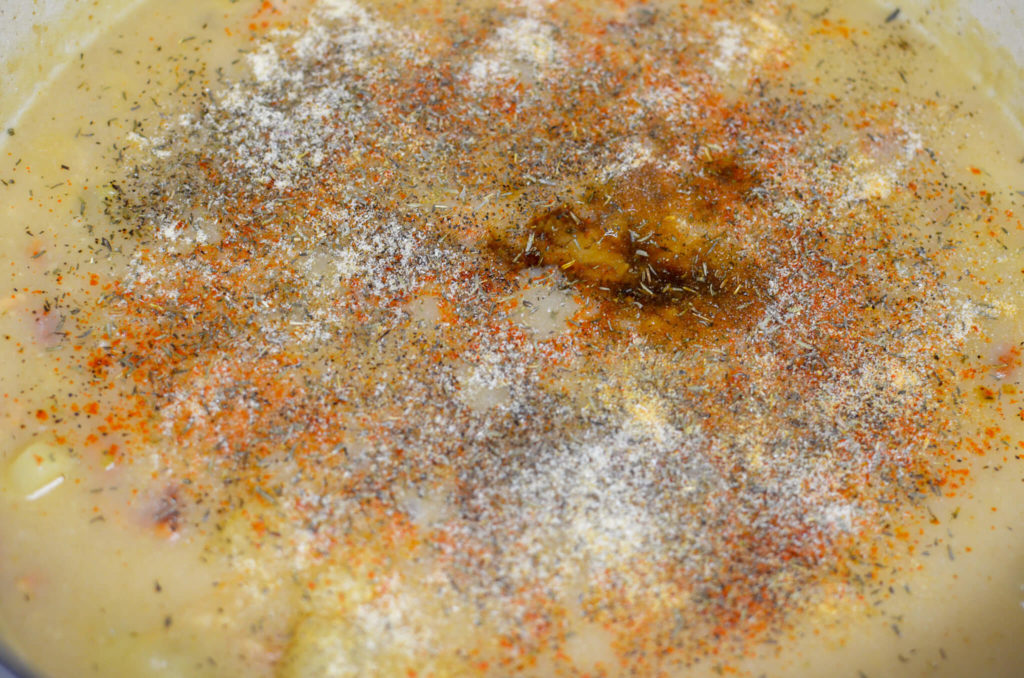
Begin to season with:
- 1 tsp salt
- 1 tsp pepper
- 1 tsp thyme
- 1 tsp paprika
- 1 tsp Worcestershire sauce
Start with less seasoning, allowing you to add more if needed. Too much spice can be overpowering.

Lastly, add the 2 cups of half & half and bring to a boil, then reduce down to simmer for another 20 minutes.
Step 5
Garnish & Enjoy Some Clam Chowder!

New England Clam Chowder is the one soup where oyster crackers are non negotiable. Add some of those and enjoy yourself a warm cup of chowder to soothe your soul.

The Departed

More About Clam Chowder
Clam chowder is a type of soup or stew that is made with clams and a variety of other ingredients, such as potatoes, onions, and celery. It is a popular dish in many parts of the world, particularly in the United States, where it is a staple of New England cuisine.
There are a few reasons why clam chowder is so popular. One reason is that it is a hearty and satisfying dish that is perfect for cold weather. The combination of tender clams and creamy broth makes it a comfort food that is both filling and flavorful.
Another reason for its popularity is that it is relatively easy to make, especially when using canned clams. This makes it a convenient and affordable option for home cooks, who can quickly and easily prepare a tasty meal without spending a lot of time or money.
Clam chowder also has a rich history and cultural significance in New England, where it has been a staple of the region’s cuisine for centuries. This history and tradition adds to its appeal, making it a dish that is both tasty and meaningful.

